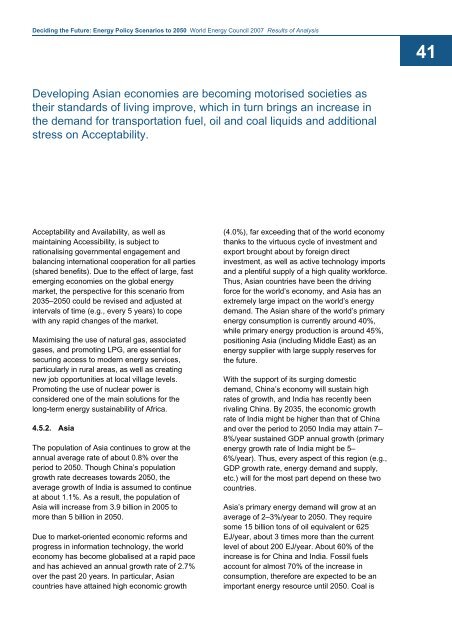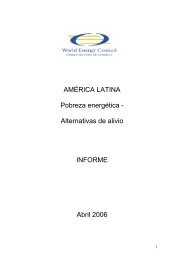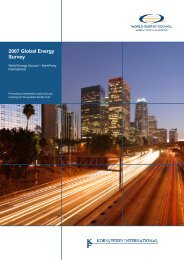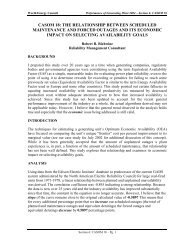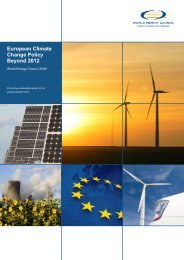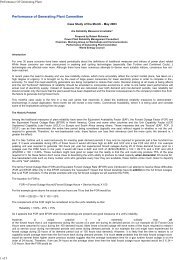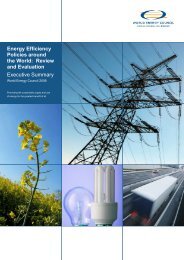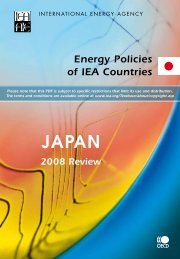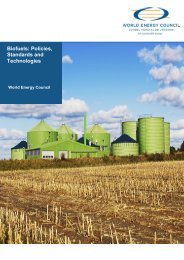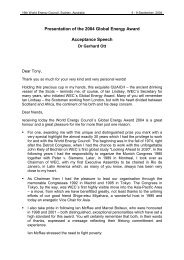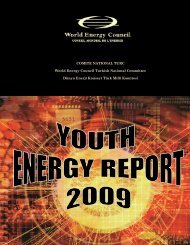Deciding the Future: Energy Policy Scenarios to 2050
Deciding the Future: Energy Policy Scenarios to 2050
Deciding the Future: Energy Policy Scenarios to 2050
You also want an ePaper? Increase the reach of your titles
YUMPU automatically turns print PDFs into web optimized ePapers that Google loves.
<strong>Deciding</strong> <strong>the</strong> <strong>Future</strong>: <strong>Energy</strong> <strong>Policy</strong> <strong>Scenarios</strong> <strong>to</strong> <strong>2050</strong> World <strong>Energy</strong> Council 2007 Results of Analysis<br />
41<br />
Developing Asian economies are becoming mo<strong>to</strong>rised societies as<br />
<strong>the</strong>ir standards of living improve, which in turn brings an increase in<br />
<strong>the</strong> demand for transportation fuel, oil and coal liquids and additional<br />
stress on Acceptability.<br />
Acceptability and Availability, as well as<br />
maintaining Accessibility, is subject <strong>to</strong><br />
rationalising governmental engagement and<br />
balancing international cooperation for all parties<br />
(shared benefits). Due <strong>to</strong> <strong>the</strong> effect of large, fast<br />
emerging economies on <strong>the</strong> global energy<br />
market, <strong>the</strong> perspective for this scenario from<br />
2035–<strong>2050</strong> could be revised and adjusted at<br />
intervals of time (e.g., every 5 years) <strong>to</strong> cope<br />
with any rapid changes of <strong>the</strong> market.<br />
Maximising <strong>the</strong> use of natural gas, associated<br />
gases, and promoting LPG, are essential for<br />
securing access <strong>to</strong> modern energy services,<br />
particularly in rural areas, as well as creating<br />
new job opportunities at local village levels.<br />
Promoting <strong>the</strong> use of nuclear power is<br />
considered one of <strong>the</strong> main solutions for <strong>the</strong><br />
long-term energy sustainability of Africa.<br />
4.5.2. Asia<br />
The population of Asia continues <strong>to</strong> grow at <strong>the</strong><br />
annual average rate of about 0.8% over <strong>the</strong><br />
period <strong>to</strong> <strong>2050</strong>. Though China’s population<br />
growth rate decreases <strong>to</strong>wards <strong>2050</strong>, <strong>the</strong><br />
average growth of India is assumed <strong>to</strong> continue<br />
at about 1.1%. As a result, <strong>the</strong> population of<br />
Asia will increase from 3.9 billion in 2005 <strong>to</strong><br />
more than 5 billion in <strong>2050</strong>.<br />
Due <strong>to</strong> market-oriented economic reforms and<br />
progress in information technology, <strong>the</strong> world<br />
economy has become globalised at a rapid pace<br />
and has achieved an annual growth rate of 2.7%<br />
over <strong>the</strong> past 20 years. In particular, Asian<br />
countries have attained high economic growth<br />
(4.0%), far exceeding that of <strong>the</strong> world economy<br />
thanks <strong>to</strong> <strong>the</strong> virtuous cycle of investment and<br />
export brought about by foreign direct<br />
investment, as well as active technology imports<br />
and a plentiful supply of a high quality workforce.<br />
Thus, Asian countries have been <strong>the</strong> driving<br />
force for <strong>the</strong> world’s economy, and Asia has an<br />
extremely large impact on <strong>the</strong> world’s energy<br />
demand. The Asian share of <strong>the</strong> world’s primary<br />
energy consumption is currently around 40%,<br />
while primary energy production is around 45%,<br />
positioning Asia (including Middle East) as an<br />
energy supplier with large supply reserves for<br />
<strong>the</strong> future.<br />
With <strong>the</strong> support of its surging domestic<br />
demand, China’s economy will sustain high<br />
rates of growth, and India has recently been<br />
rivaling China. By 2035, <strong>the</strong> economic growth<br />
rate of India might be higher than that of China<br />
and over <strong>the</strong> period <strong>to</strong> <strong>2050</strong> India may attain 7–<br />
8%/year sustained GDP annual growth (primary<br />
energy growth rate of India might be 5–<br />
6%/year). Thus, every aspect of this region (e.g.,<br />
GDP growth rate, energy demand and supply,<br />
etc.) will for <strong>the</strong> most part depend on <strong>the</strong>se two<br />
countries.<br />
Asia’s primary energy demand will grow at an<br />
average of 2–3%/year <strong>to</strong> <strong>2050</strong>. They require<br />
some 15 billion <strong>to</strong>ns of oil equivalent or 625<br />
EJ/year, about 3 times more than <strong>the</strong> current<br />
level of about 200 EJ/year. About 60% of <strong>the</strong><br />
increase is for China and India. Fossil fuels<br />
account for almost 70% of <strong>the</strong> increase in<br />
consumption, <strong>the</strong>refore are expected <strong>to</strong> be an<br />
important energy resource until <strong>2050</strong>. Coal is


